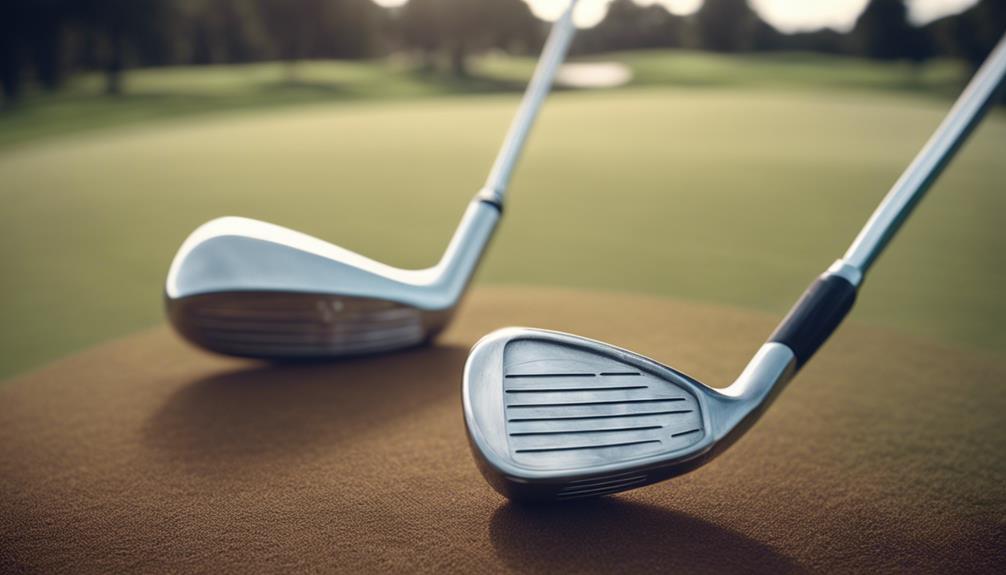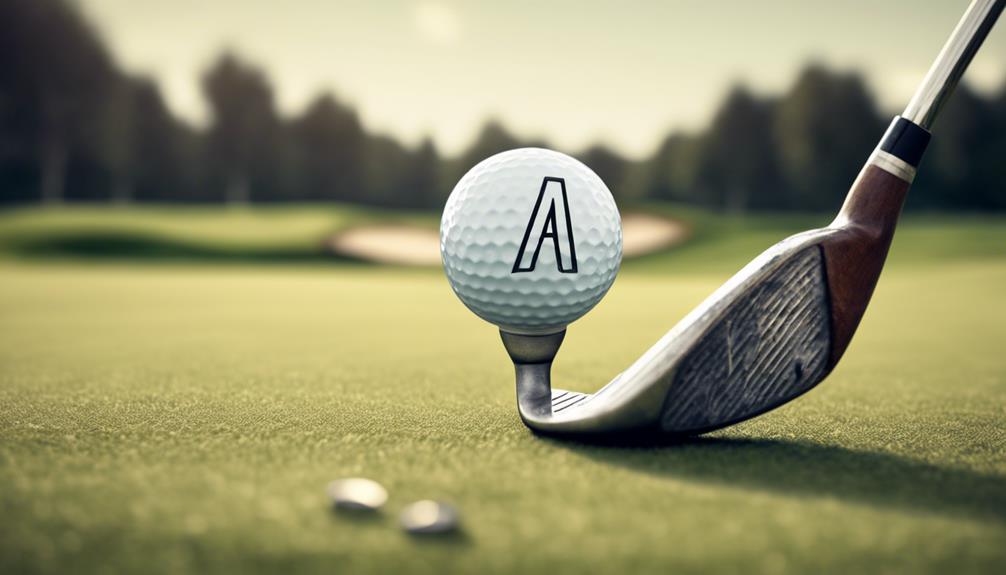- 7 Top Flite Golf Clubs XL for Improved Performance - September 28, 2024
- Top Flite Golf Clubs: Top 5 Reasons to Choose Them - September 28, 2024
- Top 3 Golf Club Fitters for a Perfect Swing - September 28, 2024
You're likely familiar with the Pitching Wedge and Sand Wedge in your golf bag, but the AW Golf Club, also known as the Approach Wedge or Gap Wedge, fills a critical loft gap between these two essential clubs. It's designed for precision in approach shots, typically lofted between 48 to 51 degrees, and provides more control over shots than a Pitching Wedge or Sand Wedge. As you explore the AW Golf Club, you'll discover its versatility in fairway, rough, and long bunker shots, and how it can improve your short game performance – and there's more to learn about how this club can take your game to the next level.
Key Takeaways
- AW in golf refers to the A-Wedge or Approach Wedge, a club designed for precision in approach shots, bridging the loft gap between PW and SW.
- The A-Wedge typically has a loft range of 48 to 51 degrees, offering more control over approach shots and versatility in various situations.
- It provides better distance management and spin control compared to a Pitching Wedge, making it an essential addition to a well-rounded golf bag.
- The A-Wedge is also known as the Gap Wedge or Utility Wedge, with different manufacturers using varied names for this type of club.
Understanding the A-Wedge Club
When you're looking to add precision to your approach shots, the A-wedge club is designed to fill a specific distance gap in your golf bag.
As an Approach Wedge, it bridges the loft gap between your Pitching Wedge (PW) and Sand Wedge (SW), typically lofted between 48 to 51 degrees. Commonly referred to as a Gap Wedge, the A-wedge provides more control over your approach shots due to its unique loft, higher than a PW but lower than a SW.
This versatility allows you to use the A-wedge for various shots, including fairway approaches, rough shots, and long bunker shots, traveling shorter than a PW but further than a SW.
By understanding the A-wedge's purpose, you can choose the right club to fill the distance gap in your set, ensuring more accurate shots.
Loft Degrees of an A-Wedge
You'll typically find that an A-wedge's loft falls between 48 to 51 degrees, with the most common options ranging from 50 to 51 degrees across various models. The loft degree of your A-wedge is critical in determining the distance it can achieve, filling the gap between your pitching wedge (around 46 degrees) and sand wedge (usually between 54 to 58 degrees).
Game-improvement A-wedges may have as little as 48 degrees of loft, while those designed for low-handicap golfers usually feature lofts ranging from 50 to 52 degrees. Different manufacturers may have varying lofts for their A-wedges, such as the P770 A-wedge at 51°, P790 A-wedge at 50°, and the 2017 M2 A-wedge at 49°.
When choosing an A-wedge, consider the loft in relation to the rest of your iron set to guarantee proper distance gaps and performance consistency. Understanding the loft degree of your A-wedge is essential for mastering your golf wedges and taking your game to the next level.
Choosing the Right A-Wedge

When selecting the right A-wedge, you'll want to take into account a few key factors to guarantee it integrates smoothly with your iron set.
You'll need to reflect on loft compatibility, your playing style, and the distance gap you're trying to fill between your pitching wedge and sand wedge.
A-Wedge Selection Guide
Frequently, golfers overlook the importance of selecting the right A-Wedge, which can make all the difference in bridging the gap between their pitching wedge and sand wedge.
When choosing an A-Wedge, verify it fits the loft range of 48 to 52 degrees, commonly found in gap wedges, to fill the distance gap effectively.
Consider the design of your iron set, as game-improvement irons often include a GW/AW option, while bladed sets may require you to choose a specific wedge that complements your pitching wedge.
Test different A-Wedge options to find one that provides a comfortable feel and aligns with your playing style, as the shaping and construction can greatly impact performance.
Look for A-Wedges that are consistent with the lofts of your other clubs, as this will help maintain proper distance gaps and improve your overall short game.
Remember, while A-Wedges can be referred to by different names, such as Approach Wedge or Gap Wedge, their primary purpose remains the same: to bridge the loft difference between the pitching wedge and sand wedge.
Gap Filling Options
To guarantee a seamless changeover between your pitching wedge and sand wedge, consider the loft gap you're trying to fill and choose an A-Wedge that bridges it effectively.
As you're selecting the right A-Wedge, remember that it should fit seamlessly with the lofts of your existing iron set, typically ranging between 48 to 52 degrees of loft.
If you're a mid to high-handicap golfer, you might find it easier to fill the distance gap with an A-Wedge option from a game-improvement iron set. However, if you're a low-handicap player using bladed iron sets, you might prefer to select a specific lofted wedge, such as a 50 or 52-degree A-Wedge, to better match your game.
When choosing an A-Wedge, pay attention to the labeling, whether it be Approach Wedge, Gap Wedge, or Attack Wedge, to guarantee you're filling the correct distance gap. Typically, this gap is around 8 to 14 degrees of loft difference between your Pitching Wedge and Sand Wedge.
Names and Labels of A-Wedges
As you explore the world of A-Wedges, you'll notice that different manufacturers use various labels to describe this club.
You might come across names like Approach Wedge, Gap Wedge, Attack Wedge, or Utility Wedge, depending on the brand you're looking at.
Let's take a closer look at these labels and how they differ from one manufacturer to another.
A-Wedge Labels
You'll notice that A-Wedges go by different names depending on the manufacturer, with some using Approach Wedge, Attack Wedge, Gap Wedge, or Utility Wedge to describe this versatile club. These labels might seem confusing, but they all refer to the same type of club.
Brands like TaylorMade and Callaway typically use the A-Wedge designation, while Cobra and Mizuno prefer the Gap Wedge name. Ping takes a different approach, designating their second wedge with a 'U' for Utility Wedge, adding another name to the A-Wedge nomenclature.
Despite these variations, the primary purpose of these clubs remains the same: to fill the loft gap between a Pitching Wedge and a Sand Wedge.
When purchasing a wedge individually, you'll often find the loft stamped on the club, such as 50° or 52°, helping you identify the specific degree of the club. Understanding the different labels and names can help you make an informed decision when choosing the right A-Wedge for your game.
Manufacturer Variations
Different manufacturers employ varied labels to describe their A-Wedges, reflecting a diverse nomenclature in the golf industry. As you explore the world of golf, you'll notice that brands like TaylorMade and Callaway often use the 'A-Wedge' designation, while Cobra and Mizuno prefer the term Gap Wedge.
Ping takes a different approach, referring to their second wedge as a Utility Wedge, marked with a 'U' for identification. Some wedges sold individually may display their loft directly, such as being stamped with numbers like 50 or 52, rather than a name.
Despite these variations, all these clubs serve the same primary purpose of filling the loft gap between the Pitching Wedge and Sand Wedge.
Regardless of the label, the A-Wedge, Approach Wedge, or Gap Wedge is designed to provide a higher trajectory and more spin than a Pitching Wedge, making it an essential club in your golf bag. By understanding the different manufacturer labels, you'll be better equipped to choose the right club for your game, ultimately leading to improved performance on the course.
Comparing A-Wedges to Other Clubs

When selecting the right club for your approach shot, understanding the unique characteristics of the A-Wedge in relation to other clubs in your bag is essential.
You'll want to evaluate the loft range of your A-Wedge, typically between 48 to 51 degrees, which fills the gap between your Pitching Wedge (PW) and Sand Wedge (SW). The PW's standard loft of around 46 degrees makes the A-Wedge's loft closer to 51 degrees ideal for shorter and softer approach shots.
Compared to a Sand Wedge, designed for higher lofted shots out of bunkers, the A-Wedge allows for more precise distance control when approaching the green. While both the A-Wedge and Pitching Wedge are used for approach shots, the A-Wedge is used for shots that require more height and spin than a PW but less than a SW.
With its versatility, the A-Wedge is suitable for various situations, including fairway, rough shots, and long bunker shots, making it a valuable addition to your club selection.
Benefits and Uses of A-Wedges
By understanding the unique characteristics of the A-Wedge, golfers can access its full potential and reap the benefits of improved distance control, trajectory, and spin, ultimately leading to better overall performance on the course.
As you incorporate an A-Wedge into your game, you'll notice significant advantages in your approach shots. With a loft between 48 to 51 degrees, this club is perfect for bridging the distance gap between your Pitching Wedge and Sand Wedge.
Here are some key benefits and uses:
- Precise distance management: Get accurate control over your approach shots, ensuring you hit the right distance every time.
- Versatility in playability: Effectively use your A-Wedge in various situations, including fairway and rough shots, as well as long bunker shots.
History and Evolution of A-Wedges

Your search for the perfect gap in your golf set led to the creation of the A-wedge, which has revolutionized the way you approach shots. Historically, golfers relied solely on pitching and sand wedges, leaving a significant distance void. The A-wedge, also known as the gap wedge, was designed to bridge this gap.
| Club | Loft Range | Typical Loft |
|---|---|---|
| Pitching Wedge | 40-48 degrees | 46 degrees |
| A-Wedge (Gap Wedge) | 46-54 degrees | 50 degrees |
| Sand Wedge | 54-58 degrees | 56 degrees |
As golf club designs evolved, the A-wedge became a standard addition to modern iron sets, allowing for more precise control over approach shots. Today, manufacturers use terms like approach wedge, attack wedge, and gap wedge interchangeably to describe this versatile club. With its unique loft range, the A-wedge has become an essential tool in your golf equipment arsenal, enabling you to tackle shots with confidence and precision. By understanding the history and evolution of the A-wedge, you can better appreciate its significance in your golf game.
Frequently Asked Questions
What Does AW Mean in Golf Clubs?
You're wondering what AW means in golf clubs. It stands for Approach Wedge, a club that fills the distance gap between PW and SW, offering precise control for approach shots with its 48-51 degree loft, versatile features, and rich history.
What Does W Stand for on a Golf Club?
As you wonder what the "W" on your golf club means, it's no coincidence that it stands for "Wedge", signifying a club designed for precision shots with higher lofts, spin, and trajectory, encompassing various types like PW, GW, SW, and LW.
What Does 8 Pw Aw Mean?
You're wondering what "8 PW AW" means? It's a golf set including an 8-iron, pitching wedge, and approach wedge, offering advantages like precise distance control and versatility in your short game, with lofts ranging from 46-51 degrees, crafted from various materials.
What Is the Difference Between Pw, Aw, Sw, and Lw?
As you navigate the green, you're wondering what sets PW, AW, SW, and LW apart. It's all about loft and club selection, mastering your short game by choosing the right wedge for the shot, from PW's longer approaches to LW's high, precise arcs.
Conclusion
As you stand on the course, A-Wedge in hand, remember that it's not just a club, it's a problem-solver.
Like a trusty sidekick, it helps you navigate tricky lies and tight spaces.
Think of it as a key that releases a world of possibilities, just like how a master locksmith can open even the most stubborn doors.
With the right A-Wedge, you'll be slicing through challenges like a hot knife through butter, and your game will reveal a new level of precision and confidence.




